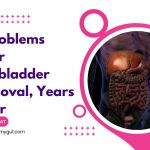Excess Bile Production: Symptoms & Causes.
Our content is not intended nor recommended as a substitute for medical advice by your doctor. Use for informational purposes only.
(Excess bile production) is not a common term that we use as doctors. We instead use the word (Jaundice) to describe increased Bilirubin levels inside the body.
Excess bile production is one of the causes of jaundice. However, jaundice can occur due to causes other than increased bile production, such as (reference):
- Obstruction of the bile outflow from the liver (Such as stones obstructing the common bile duct).
- Acute liver inflammation (acute hepatitis).
- Chronic end-stage liver diseases (liver cirrhosis).
- Congenital diseases of bile metabolism such as gilbert syndrome.
The table below summarizes the leading causes of excess bile production and excess bile in stool.
| Condition. | Common causes (Examples) |
| The actual increase in bile production. | – Hemolytic anemia. – Megaloblastic and sideroblastic anemia. – Internal bleeding. |
| Excess bile in stool | – Severe diarrhea (bilirubin secreted unchanged in stool). – Bile acid diarrhea (BAD). -Recent removal of the gallbladder. |
| Impaired bile excretion (cholestasis). | – BIle duct obstruction. – Acute and chronic liver diseases. – Drugs. |
The symptoms of Excess bile production include:
- Jaundice: yellowish skin, eye whites, and mouth.
- Dark urine.
- Clay (pale stool).
- Severe right upper abdominal pain.
- Signs of anemia (fatigue, shortness of breath, pallor, fast heartbeat, fainting).
- Signs of liver failure: coma, swollen limbs, swollen abdomen, muscle wasting, etc.
- Unexplained fever or severe abdominal pain.
- Severe diarrhea.
A. Actual increase in bile production.
Bile is the end product of hemoglobin (the molecule that carries oxygen inside your red blood cells). Your red blood cells (RBCs) have an average life span of about four months.
When the RBCs die, The hemoglobin is released and broken down, and the liver processes it to produce bile (reference). Bile is then secreted through the bile ducts into the gastrointestinal tract to help fat digestion.
Causes and symptoms of Increased bile production:
1. Hemolytic anemia.
Hemolytic anemia is a type of anemia (low hemoglobin levels) due to abnormally increased destruction (hemolysis) of RBCs.
Hemolytic anemia can be due to congenital defects in the production of hemoglobin or RBCs or due to acquired causes (reference).
A. Hereditary hemolytic anemias:
- Thalassemia.
- Sickle cell disease.
- G6PD deficiency (Favism).
- Other less common types such as hereditary spherocytosis, etc.
B. Acquired Hemolytic anemias:
- Autoimmune hemolytic anemia.
- Drug-induced hemolytic anemia.
- Paroxysmal Nocturnal hemoglobinuria
- And others.
Symptoms (Anemia + Bilirubin Excess symptoms):
- Easy fatigue.
- Dizziness, headache, lack of concentration, and blurring of vision.
- Fast heartbeats.
- Shortness of breath on exertion.
- Skin color is yellowish and pale.
- Yellowish discoloration of the eye whites and the mouth.
- Inability to handle physical activity.
- Sometimes, Dark or tea-colored urine.
- Long-standing hereditary anemias can cause enlarged spleen and liver (left and right upper quadrant pain or heaviness).
- The release of too much iron from the destructed RBCs can cause the darkening of the skin (hyperpigmentation).
2. Other types of anemias leading to bile excess.
- Sideroblastic anemia: Abnormal iron utilization by the body leading to abnormal RBCs.
- Megaloblastic anemias: due to vitamin B12 defeciency.
These two types of anemia can also cause jaundice due to bile overproduction.
The symptoms of anemia are the same as above. In addition, jaundice can occur but is not common.
3. Internal bleeding.
The pooling of large amounts of blood to the outside of blood vessels can also cause symptoms of excess bile production.
The most common causes of internal bleeding are:
- Major trauma (as with road traffic accidents or falls from height).
- Bleeding after surgery.
- Spontaneous internal bleeding with blood diseases or with blood-thining medications.
Internal bleeding should be large to cause significant excess bile production. The cause is that red blood cells (RBCs) are degraded and produce excess bile.
Symptoms:
- History of the cause (trauma, blood disease, blood-thinning drug).
- Symptoms of bleeding: severe pain, fast heartbeats, dizziness, fainting, low blood pressure, shortness of breath, etc.
- Symptoms of excess bile production: yellow skin, yellowish eye whites, etc.
- Symptoms of anemia: fatigue, inability to tolerate physical activity, dizziness, headache, vertigo, bringing of ears, fast heartbeats, etc.
B. Excess bile in the stool.
As we explained before, bile is produced by the liver and transferred into the gut. Then, 95% is reabsorbed into the body (circulation to be utilized again).
Bile is green under normal conditions. However, the green bile is chemically transformed into a brown substance inside the intestine, giving the stool its brown color.
Some conditions may cause excess bile or bile acids in the stool without increasing bile production by the liver.
Excess bile in stool can be due to:
1. Bile acid diarrhea (BAD):
Bile acid diarrhea is a condition in which bile acids are not adequately processed inside your digestive system.
Usually, most bile acids are reabsorbed back into the circulation through the intestine. However, with BAD, your body is unable to reabsorb bile acids. So, they stay longer inside your intestine and travel into the colon.
This causes excess bile acids in the stool due to its malabsorption, leading to bile acid diarrhea.
Symptoms:
- Diarrhea (especially after fatty meals): caused by excess bile in stool and fat malabsorption.
- Extreme urgency: a sudden severe urge to poop. It is a characteristic symptom of BAD.
- The extreme urgency may lead to soiling accidents (stool incontinence) in some people.
- Unlike IBS, diarrhea can occur at night (awakens you from sleep).
- Abdominal pain and stomach gurgling after meals.
- Bloating and flatulence.
Learn More about bile acid diarrhea.
2. Severe attacks of diarrhea.
The bile secreted from the liver is often greenish. It is chemically processed inside your digestive tract to a brownish substance which gives the stool its characteristic brown color.
Severe attacks of acute diarrhea (as with acute gastroenteritis) speed up the passage of bile through the intestine.
The rapid gush of bile through your digestive tract will not allow bile to be processed into its final brownish substance.
This leads to excess greenish bile in the stool with severe attacks of diarrhea.
The symptoms often start with normal yellow watery stool. Then, diarrhea may turn green with repeated attacks of diarrhea.
The bile excess in stool often resolves as diarrhea improves.
3. Recent gallbladder removal surgery.
The gallbladder serves as a reservoir for bile until the next meal. The gallbladder contracts to empty its bile content into the digestive tract when you eat.
When the gallbladder is removed, your liver directly and continuously secrets bile into the digestive tract (no storage).
The excess bile may exceed your digestive system’s capacity to handle it. As a result, bile passes in excess with stool.
Symptoms:
- History of recent gallbladder removal surgery.
- Postcholecystectomy diarrhea affects up to 20% of patients after cholecystectomy operations.
- The diarrheal attacks often resolve after a few weeks or months. However, some may continue to have diarrhea for years.
- Intolerance of fatty meals.
- Bloating.
- Abdominal pain.
- Constant indigestion or discomfort.
- Yellowish or greenish stool.
Does the pancreas Produce bile? & Why bilirubin is affected in pancreatic diseases.
C. Cholestasis: Excess bile due to impaired bile excretion.
Bile may increase inside your blood and body tissue due to impaired excretion from the liver.
In such a case, there is no increase in bile production but an accumulation of the bile inside your body due to impaired excretion.
The condition is called (cholestasis), and it occurs due to various conditions such as:
- Obstruction of bile flow due to liver diseases (hepatocellular jaundice).
- Block of the bile ducts delivering bile from the liver to the digestive tract (obstructive jaundice.
The causes of hepatocellular jaundice and obstructive jaundice are in the table below (reference).
| Type | Common Causes. |
| Hepatocellular jaundice | – Acute hepatitis (infection is the most common cause). – Acute liver failure. – Drug-induced cholestasis. – Liver Toxins. – Large liver tumors (liver cancer or liver metastasis). – Liver cirrhosis for any cause. |
| Obstructive jaundice. | – Stone inside the common bile duct. – Pancreatic cancer or severe acute pancreatitis. – Bile duct stensos or stricuture. – duodenal cancer obstructs the opening of CBD. |
Symptoms:
The symptoms are highly variable and depend on the original cause of excess bile in your body.
- Symptoms of jaundice: dark urine, yellow skin, Yellow eye whites, Pale stools.
- Symptoms of acute liver disease include right upper abdominal pain, fatigue, and jaundice.
- Symptoms of liver cirrhosis include swelling of the abdomen, swelling of the lower limbs, black stools, vomiting of blood, coma (hepatic encephalopathy), muscle wasting, etc.
- Symptoms of biliary problems: such as biliary colic (severe right upper abdominal pain, nausea, vomiting, etc.).
MORE: Is there a Test For gallstones At home?
When to see a doctor:
Excess bile production often reflects a disease. Consult your doctor once you experience one or more of the symptoms of bile excess.
See a doctor if:
- Jaundice: yellowish skin, eye whites, and mouth.
- Dark urine.
- Clay (pale stool).
- Severe right upper abdominal pain.
- Signs of anemia (fatigue, shortness of breath, pallor, fast heartbeat, fainting).
- Signs of liver failure: coma, swollen limbs, swollen abdomen, muscle wasting, etc.
- Unexplained fever or severe abdominal pain.
- Severe diarrhea.
- Evidence-based
- Written by a doctor.

Related Posts:
- 6 Colon Cancer Symptoms in Women: Doctor Explains.
- Does the pancreas Produce bile? & Why bilirubin is…
- Unexplained Diarrhea & No Other Symptoms: 9 Common Causes.
- Yellow diarrhea: 12 Causes, Doctor Explains.
- Does Pepsi Help with Nausea? (GI Doctor Explains)
- Can Vomiting Blood Cause Death? Doctor Explains.





